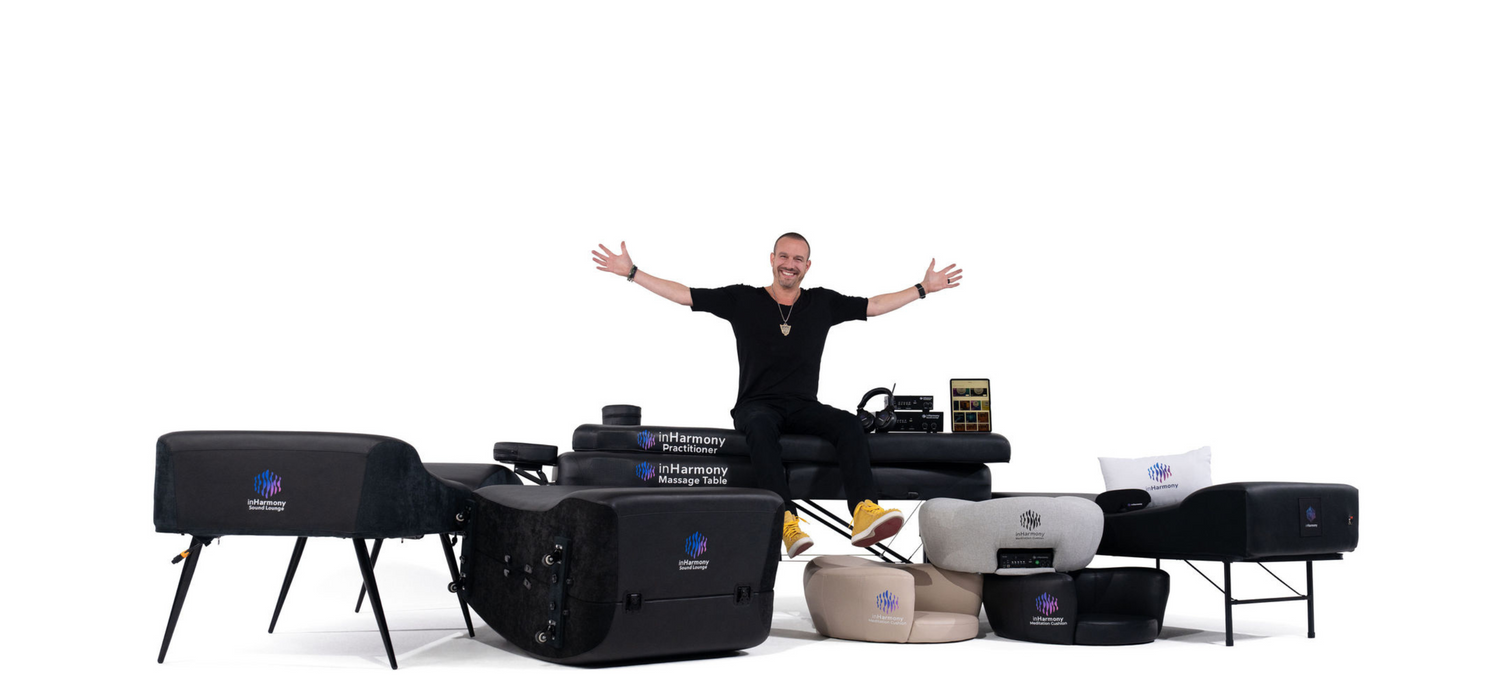A new application of sound resonance technology therapy for the treatment of fibromyalgia: A retrospective analysisJennifer Cogana,×, Michel Camusb,f, Jean-Franc- ois Saucierc,Pierre Arsenaultd, Jocelyn Demerse
aDepartment of Anesthesiology, Montreal Heart Institute and Universite´ de Montre´al, 5000 Belanger Street, Montreal, Que., Canada H1T 1C8
bSocial and Preventive Medicine, Universite´ de Montre´al, Montreal, Que., Canada H3C 3J7
cResearch Center, Ste-Justine Hospital, Faculty of Medicine, Universite´ de Montre´al, and Psycho Physio,
Montreal, Que., Canada H3S 1W3
dDepartment of Family Medicine, Faculty of Medicine, Universite´ de Sherbrooke, Sherbrooke, Que.,
Canada J1H 5N4
eClinique Psycho Physio, Montreal, Que., Canada H3G 1P5
fEpidemiology and Biostatistics Division, Safe Environments Program, Health Canada, Ottawa, Ont., Canada K1A 0J9
Summary
Objective: Chart review to evaluate the effectiveness of a three-phase sound resonance technology therapy (SRTT) protocol for the treatment of fibromyalgia. Results: Initial FIQ scores of 159 consecutive patients ranged from 24 to 80
(mean 58). After Phase 1, (E1 month into the protocol), FIQ scores had decreased on average by 26 points (n 128, 95% CI 23–30, po.001). After phase 3 of the protocol 53 patients completed an FIQ questionnaire and the mean decrease in FIQ score was 38 points (95% CI 32–44, p .004).
Conclusions: This retrospective analysis suggests considerable and rapid relief of the symptoms of fibromyalgia following the use of the three-phase SRTT treatment protocol, which appears to be maintained over several years. Although these results are not conclusive they are remarkable as no other therapy reported in the scientific literature seems as efficacious for fibromyalgia. A follow-up study using an RCT design is warranted.
& 2006 Elsevier Ltd. All rights reserved.
×Corresponding author. Tel.: +514 376 3330x3732; fax: +514 376 8784.
E-mail address: jennifer.cogan@umontreal.ca (J. Cogan).
1744-3881/$ - see front matter & 2006 Elsevier Ltd. All rights reserved. doi:10.1016/j.ctcp.2006.04.001
Introduction
Fibromyalgia (FM) was first described by Balfour in 1810. It is a chronic pain syndrome of unknown aetiology experienced by 10–12% of the population at any one time or up to 6% of the patients seen in general medical practice.1,2 It is characterized by chronic widespread joint and muscle pain, and may include cardiovascular, digestive, genitourinary, endocrine, CNS and psychological symptoms.3,4 It affects women more frequently than men, the ratio varying between studies from 9:15 to 20:16 and is quite costly physically, emotionally and economic- ally. A recent study using overall beneficiary and employee-only samples from an employer data set estimated the annual cost for FM claimants as $5945 US dollars as compared $2486 for typical benefici- aries.7 This includes treatment of co-morbid condi- tions and work loss costs to the employer.
The pathogenesis of FM appears to be multi-
factorial and may vary from individual to individual. Diagnosis and treatment remain a challenge as no gold standard for diagnosis has been established and no single treatment has proven efficient. A sys- tematic review of randomized controlled trials (RCT) for nonpharmacological interventions in 2002 8 yielded 25 RCTs in which the main interven- tions evaluated were exercise therapy, educational intervention, relaxation therapy, cognitive–beha- vioural therapy, acupuncture and hydrotherapy. Conclusions were that strong evidence did not emerge for any single intervention though there was some support for aerobic exercise.
In 2004, Goldenberg et al.1 published a systema-
tic review with the objective of providing up-to- date evidence-based guidelines for the optimal treatment of FM. He concluded that current evidence supports stepwise programs which in- clude: (1) an emphasis on education; (2) certain medications such as tricyclic antidepressants, or SSRI’s; (3) exercise such as cardiovascular and strength training; (4) cognitive therapy; or (5) the combination of all four of these approaches.
In this paper we present the results of a retro- spective analysis of 131 consecutive patients with FM who, between June 1996 and May 2004 under- went a three-phase protocol in a psychotherapeutic clinic, which included sound resonance technology (SRT), psycho-coaching and integrative follow-up.
Sound resonance therapy background
SRT therapy (SRTT) is based on the ‘‘disregulation model’’,9,10 which proposes that emotions influ- ence neurobiological functions which accompany
them and may contribute to their disregulation. This model does not posit causality but rather that a deficit in the cognitive processing of emotion may bring about changes in the endocrine and auto- nomic nervous systems that ultimately influence physical health. The model draws on the concept of alexithymia which was originally defined by Ne- miah11 as a ‘‘multifaceted construct encompassing three factors: difficulty identifying feelings, diffi- culty describing feelings and externally oriented thinking’’12 and implies that dysfunctional cogni- tive processing may play a role in the pain experience.13 It has been used for the treatment of pain and depression.14,15
Sound resonance technology
SRT uses a vibro-acoustic apparatus that simulta- neously stimulates the auditory and the somato- sensory system of an individual, triggering long- term memory. Edleman proposes a neurological model based on the neural group selection to explain the basics in human behaviour.16,17 But more importantly, it can explain the mechanisms that link psychology and physiology. Psychological trauma can influence neurons in their development stages and form distinct neurological imprints. The imprints are influenced by any significant life experience. SRT stimulates the neurological im- prints. This permits the release and surfacing of intense emotional feelings which may then be dealt with at a cognitive level. The acknowledgement of these memories and the resolution of the issues they raise, through psychological counselling and the consequent changes in attitudes and lifestyle, promotes the regression of the symptoms of FM.
SRTT procedure
This therapy involves a three-phase programme. The first phase, SRT, includes 16–20 sound reso- nance sessions of 42 min duration. Each session (two per day for 10 days) is followed by a rest period in which the participants transcribe their memories, thoughts and feelings. The second phase, Psycho-coaching, involves a private, 2- to 4-week intensive psychotherapy of approximately 27 h in total, i.e. 2–3 h/day. These sessions are designed to identify the connection between stressful elements of the participants’ lives and their physical and psychological consequences using the written material generated after the SRT sessions. The third and final phase is one of
Integration. It is designed to consolidate, in every- day life, the awareness gained in phases 1 and 2. Meetings are initially scheduled every 2 weeks and may be modified, at therapist’s discretion, accord- ing to the patient’s progress. Overall, the intensive phase of treatment lasts 4 weeks (2 weeks of SRT and 2 weeks of psychotherapy) and the consolida- tion phase lasts up to 11 months, although for many patients it requires only 5 or 6 months.
The treatment outlined above was carried out in the same manner throughout the duration of the study.
Patients and methods
Population
This paper presents data on all consecutively admitted patients presenting to a private clinic with FM. The patients were referred by either a physician, a friend or by themselves, and included both primary fibromyalgic patients, i.e. those without another known specific disease, and secondary fibromyalgic patients those with an associated disease such as rheumatoid arthritis, lupus, hypothyroidism, major depression, etc.
Methods of data acquisition
A systematic review of all charts of patients treated for FM at the clinic between 1996 and 2004 was carried out. During their 1 yr of treatment patients had completed the FM impact questionnaire (FIQ) at several time points: (1) baseline (pre-treatment); (2) 1 month (Phases 1 and 2 completed); and (3) 6 and 12 months (Phase 3 completed). Following the 1 yr treatment, if they periodically called the clinic for follow-up they were asked to complete an FIQ over the phone. All patients signed an informed consent.
Outcome measure
The FIQ is a multidimensional, self-administered questionnaire designed to measure the components of health status that are believed to be most affected by FM. The questionnaire consists of ten items that measure physical functioning, work status, depression, anxiety, sleep pain, stiffness, fatigue and well being. The first item assesses the patient’s ability to do large muscle tasks and contains ten sub-items, scaled in a Likert format from 0 ‘always able to do’ to 3 ‘never able to do.’ The second and third items ask patients to circle the number of days in the past week that
they felt good and the number of days that they missed work. The last seven items are all measured on 10 mm visual analogue scales ranging from 0 to
10 with 10 greatest impairment. The items evaluated are: ability to do job, pain, fatigue, morning tiredness, stiffness, anxiety and depres- sion. Individual scores are combined into a total FM impact score whose results may range from 0 to 80. The average FM patient scores about 50, severely afflicted patients usually score 70 plus.5
When the questionnaire was first developed patients who were not working outside the home were asked to skip the two questions related to work. Therefore a total score was made from eight items. Since the 1997 revision the work items have contained house work and therefore those who use the questionnaire need to indicate in their pub- lication how many items they are tabulating, either eight or ten. In our use of the questionnaire, as in the use made by the Mayo Clinic18 we did not include the two scores dealing with work status because these questions are not relevant for many patients. The FIQ has demonstrated test–retest reliability, content and construct validity and has wide use in FM research.5
Data analysis
Characteristics and pre-treatment FIQ scores of the 159 patients admitted to the clinic during the study period were described by treatment phase com- pleted: initial admission (pre-treatment), 1 month (Phase 2), 6 months (half-way into Phase 3) and 1 year (Phase 3 completed). To test for possible initial differences and biases in individual treat- ment and follow-up patterns, proportions or means of these variables were compared across treatment phases using standard t-tests (between treated and untreated), linear regression and a nonparametric
test for trend based on the Wilcoxon rank–sum test.19,20
FIQ scores were calculated using the following formula: (1/3)*FIQ1+(10/7)*FIQ2+FIQ5+FIQ6+FIQ7+
FIQ8+FIQ9+FIQ10. This calculation excludes the third and fourth questions (FIQ3 and FIQ4) dealing with work status, to increase validity and compar- ability with the Mayo Clinic study.18 The outcome measure used was the difference in FIQ scores between the baseline FIQ at admission to the clinic and the FIQs at 1 month, 6 months and 1 year. The primary outcome was set a priori at 1 month in order to evaluate the effects of SRT treatment within the time frame most generally used for nonpharmaclogical interventions and to compare our results with those of the Mayo Clinic. The
distribution and sampling statistics of the FIQ scores and differences are presented, and the differences were tested using the classic paired t- test. Patient characteristics available from the clinic’s registry are: age, sex, duration of symptoms and history of depression.
Results
Between 10 June 1996 and 15 May 2004, 159 patients consulted for treatment of FM. Patients ranged in age from 15 to 68 yr (mean 47 yr, SD 10 yr) and 8.8% were men. After initial enquiry into the method 131 patients completed both a pre-treatment and at least one post- treatment FIQ. Of these, we have 1 month data for 128 patients. Additionally, we have FIQ follow- up information on 56 patients at 6 months, and for 53 patients at 12 months.
Figure 1 presents FIQ scores calculated using 8/ 10 items over all patients traced that had at least one pre-treatment and one post-treatment FIQ. It shows a highly statistically significant decrease in FIQ scores at 1 month. After 1 month of treatment,
123 (93.7%) of 131 patients had some improve- ment, with a median decrease of approximately 26 points.
Table 1 shows notable differences after 1 month of treatment, between the results obtained in Montreal and those obtained at the Mayo Clinic. Initial FIQ scores in this study ranged from 24.9 to
76.7 of a potential maximum of 80 using the 8/10
items (as in the Mayo Clinic study). At 1 month post- treatment the mean SSRT total FIQ score is 28.0 (SD 14.3) while in the Mayo Clinic study it is 44.7 (SD 13.4).
An assessment of the impact of the intervention in terms of percent decrease in total FIQ at 1 month shows that a full 50% of patients had a decrease in FIQ scores of 50% or more and that another 23% had a decrease of at least 25% which reaches the level of significance suggested for an effective treatment in the article by Worrel et al. of 30% (Fig. 2). The bar graph represents the number of patients achieving each of the percent changes in total FIQ, while the line graph represents the cumulative percent of patients achieving each of the percent changes in total FIQ.
Discussion
Our retrospective data suggest that a 1 month intensive treatment using the SRTT procedure may be effective in reducing symptoms associated with FM. The overall FIQ score was significantly reduced after 1 month of treatment, and the subscales of: physical impairment, number of bad days per week, pain, morning and daytime fatigue, awakening refreshed, stiffness and nervousness and anxiety score showed a statistically significant decrease at 1 month of approximately 2.88 points, whereas in the Mayo Clinic study,18 in a 12 h programme conducted over a day and a half, only 6/8 subscales showed a significant decrease and the average
Figure 1 FIQ scores for all patients traced that had at least one pre-treatment and one post-treatment FIQs.
Total FIQ
51.4 (11.2)
28.0 (14.3) —23.4 (o.0001) 51.8 (11.08) 44.72 (13.40) —7.2 (o.001)
Physical activity
4.4 (2.2)
2.5 (2.2) —1.9 (o.0001) 1.20 (.67) 1.11 (.66) —.1 (.11)
impairment
Bad days
7.5 (2.2)
3.8 (2.7) —3.7 (o.0001) 5.45 (1.73) 4.21 (1.68) —1.3 (o.001)
Pain
6.6 (1.9)
3.8 (2.5) —2.8 (o.0001) 7.09 (1.65) 5.76 (1.82) —2.3 (o.001)
Fatigue
7.4 (2.0)
Awaken refreshed
7.4 (2.1)
4.0 (2.6) —3.4 (o.0001) 7.65 (2.23) 6.85 (2.44) —.8 (.001)
Stiffness
6.8 (2.1)
3.5 (2.3) —2.7 (o.0001) 7.69 (1.54) 6.80 (2.16) —.9 (o.001)
Nervousness and
6.6 (2.3)
3.7 (2.3) —2.9 (o.0001) 5.47 (2.44) 4.67 (2.62) —.8 (.009)
anxiety
Depression
4.8 (2.9)
2.0 (2.0) —2.8 (o.0001) 4.28 (3.01) 3.80 (2.93) —.5 (.06)
50 100
40 80
30 60
20 40
10 20
0
-75
-50
-25
-10
0
0 +10 +25 +50 +100
Percent change in total FIQ at one month
Figure 2 Impact of the SRT intervention in terms of percent decrease in total FIQ at 1 month.
decrease was much smaller being approx. .91 points. The SRTT results also compare favourably to other studies such as those by Turk21 and Gowan22, Gowan et al. used an 18 h programme conducted over 6 weeks (3 h/week) and showed a statistically significant difference in only 2 of 8 subscales, while Turk used a 4 week interdisciplinary programme consisting of 6 half-day sessions (24 h) and showed a significant decrease in FIQ scores for only 4 of 8 subscales. Neither of these studies gave an overall FIQ score.
As in most of the published literature on FM this paper focuses on the level of improvement obtained at 1 month post-treatment. However, we
also present 6 month and 1 yr follow-up data for a small number of patients. Although not conclusive, the trend of decreasing FIQ persists (p .004) and stabilizes with a median decrease of 38 points after
1 year (n 53). Though patient information is minimal it appears to remains low up to 6, 7 and 8 yrs (n 12, 8 and 3, respectively).
Unfortunately, although most patients were referred by a physician, and all patients had a presumed diagnosis of FM, no formal evaluation, using the criteria of the American College of Rheumatology was performed; however, the initial scores from our data base on the FIQ are compar- able to the initial FIQ scores noted by Worrel
et al.18 leading us to believe the populations are comparable.
In addition, issues of data acquisition may be a concern when dealing with retrospective analysis. We dealt with this by independently cross checking the charts of 30 patients and we found almost 100% concordance with the data originally entered by the clinic staff. Finally, one must consider the possibility of selection bias towards positive re- sponders. Of 159 patients 28 had a first consult and decided not to initiate therapy. Given the magni- tude of the effect seen here it is unlikely that the inclusion of 28 non-responders would have com- pletely negated these results.
In conclusion this retrospective analysis of the use of SRTT shows two major events which have not been documented previously in relation to either medical or non-medical treatments for FM. Not only is there a clinically and statistically significant decrease in FIQ scores in the first month after treatment but there is a continued decrease over the first year following treatment which is sus- tained over a lengthy follow-up period of 8 yrs. Although there may be reason to believe that SRTT acts by activating the endogenous pain inhibitory mechanism, due to the intrinsic of limitations of the design, this remains a hypothesis to be explored. The results are, nevertheless, sufficiently intriguing to warrant further rigorous scientific investigation.
What is already known on this topic
FM affects a significant proportion of the popula- tion, is costly both emotionally and economically and is difficult to treat.
The most successful treatments to date are multidisciplinary stepwise programs that have shown only moderate success in decreasing the symptoms of FM.
SRTT has been used for the treatment of depression and pain.
What this study adds
The data suggests that the use of a three-phase SRTT treatment protocol may provide considerable and rapid relief of the symptoms of FM.
The improvement appears to be maintained over several years.
There is sufficient evidence to warrant a RCT to investigate the application of SRTT for the treat- ment of FM.
Acknowledgements
We would like to thank the director and personnel of the clinic for the open and unrestricted access to the database that they provided as well as the helpful and facilitating attitude during the writing of this article.
References
Goldenberg DL, Burckhardt CS, Crofford L. Management of fibromyalgia syndrome. JAMA 2004;292:2388–95.
Nampiaparampil DE, Shmerling RH. A review of fibromyalgia.
Am J Manage Care 2004;10:794–800.
Aaron LA, Buchwald D. Chronic diffuse musculoskeletal pain, fibromyalgia and co-morbid unexplained clinical conditions. Best Pract Res Clin Rheumatol 2003;17:563–74.
Aaron LA, Buchwald D. Fibromyalgia and other unexplained clinical conditions. Curr Rheumatol Rep 2001;3:116–22.
Burckhardt CS, Clark SR, Bennett RM. The fibromyalgia impact questionnaire: development and validation. J Rheu- matol 1991;18:728–33.
Schneider MJ. Tender points/fibromyalgia vs trigger points/ myofascial pain syndrome: a need for clarity in terminology and differential diagnosis. J Manipulative Physiol Ther 1995;18:398–406.
Robinson RL, Birnbaum HG, Morley MA, Sisitsky T, Greenberg PE, Claxton AJ. Economic cost and epidemiological char- acteristics of patients with fibromyalgia claims. J Rheumatol 2003;30:1318–25.
Sim J, Adams N. Systematic review of randomized controlled trials of nonpharmacological interventions for fibromyalgia. Clin J Pain 2002;18:324–36.
Taylor GJ, Parker JD, Bagby RM, Bourke MP. Relationships between alexithymia and psychological characteristics associated with eating disorders. J Psychosom Res 1996;41:561–8.
Taylor GJ, Parker JD, Bagby RM. Emotional intelligence and the emotional brain: points of convergence and implications for psychoanalysis. J Am Acad Psychoanal 1999;27:339–54.
Nemiah JC. Alexithymia: a view of the psychosomatic process. In: Hill OW, editor. Modern trends in psychosomatic medicine. London: Butterworths; 1976. p. 430–9.
Taylor GJ. Mind–body–environment: George Engel’s psycho-
analytic approach to psychosomatic medicine. Aust N Z J Psychiatry 2002;36:449–57.
Sayar K, Gulec H, Topbas M. Alexithymia and anger in patients with fibromyalgia. Clin Rheumatol 2004;23:441–8.
Boyd-Brewer CMR. Vibroacoustic sound therapy improves pain management and more. Holist Nurs Pract 2006;18: 111–8.
Skille O, Wigram J, Weekes L. Vibroacoustic therapy: the therapeutic effect of low frequency sound on specific disorders and disabilities. J Br Music Ther 1989;3:6–10.
Edelman GM, Reeke GN, Gall WE, Tononi G, Williams D, Sporns O. Synthetic neural modelling applied to a real-world artifact. Proc Natl Acad Sci USA 1992;89: 7267–71.
Edelman GM. Neural Darwinism: the theory of neuronal group selection. New York: Basic Books; 1987.
Worrel LM, Krahn LE, Sletten CD, Pond GR. Treating fibromyalgia with a brief interdisciplinary program: initial
outcomes and predictors of response. Mayo Clinic Proc
2001;76:384–90.
Cuzick J. A Wilcoxon-type test for trend. Stat Med
1985;4:87–90.
Altman DG. Practical statistics for medical research. London: Chapman & Hall; 1991.
Turk DC, Okifuji A, Sinclair JD, Starz TW. Interdisciplinary treatment for fibromyalgia syndrome: clinical and statistical significance. Arthritis Care Res 1998;11:186–95.
Gowans SE, deHueck A, Voss S, Richardson M. A randomized, controlled trial of exercise and education for individuals with fibromyalgia. Arthritis Care Res 1999;12:120–8.



